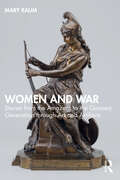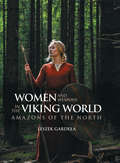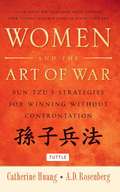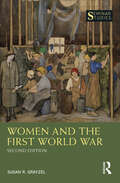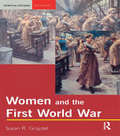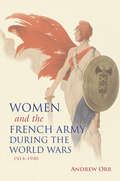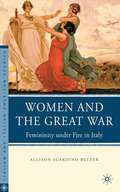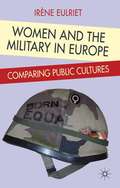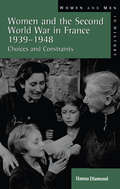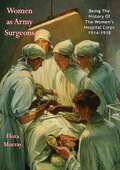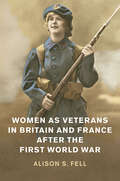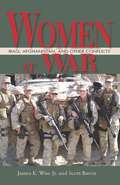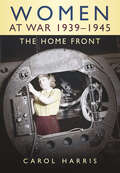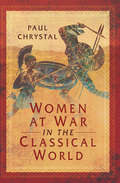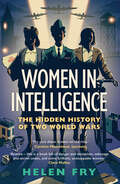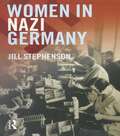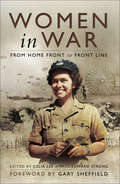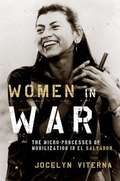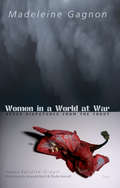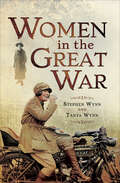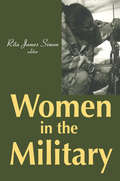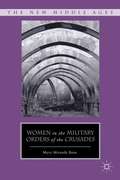- Table View
- List View
Women and War: Stories from the Amazons to the Greatest Generation through Art and Artifacts
by Mary RaumThis volume explores how art and artifacts can tell women’s stories of war—a critical way into these stories, often hidden due to the second-tier status of reporting women’s accomplishments. This unique lens reveals personal, cultural, and historically noteworthy experiences often not found in records, manuscripts, and texts. Nine stories from history are examined, from the mythical Amazons of Ancient Greece to a female prisoner of war during World War II. Each of the social, political, and battlefield experiences of Penthesilea, Artemisia, Boudica, the feminine cavaliers, the Dahomey Amazons, suffragists, World War I medical corps, and a World War II prisoner of war are intertwined with a particular work of art or an artifact. These include pottery, iconographic images, public sculpture, stone engraving, clothing, decorative arts, paintings, and pulp art. While each story stands alone, brought together in this volume they represent a cross-sectional reflection on the record of women and war. The chapters cover not only a diverse range of women from around the globe - the African continent, the Hispanic territory of Europe, Carian and Ancient Greece and Rome, Iran, Great Britain-Scotland-ancient Caledonia, Western Europe, and North America—but also a diverse choice of artwork and artifacts, eras, and the nature of the wars being fought.This book will be of value to those interested in gender across history and its interplay in the field of war.
Women and Weapons in the Viking World: Amazons of the North
by Leszek Gardela&“Invigorating . . . Gardeła reappraises the connections between women and violence in an early-medieval society that has left few texts to guide us.&” —Studies in Late Antiquity This book sets out to investigate the idea of &“the armed woman&” in the Viking Age through a comprehensive and cross-cultural approach and weaves a nuanced picture of women&’s lives in the Viking world. The Viking Age (c. AD 750–1050) is conventionally portrayed as a tumultuous time when hordes of fierce warriors from Scandinavia wreaked havoc across the European continent and when Norse merchants traveled to distant corners of the world in pursuit of slaves, silver and exotic commodities. Until fairly recently, Norse society during this pivotal period in world history has been characterized as male-dominated, with women&’s roles dismissed or substantially downplayed. There is, however, ample textual and archaeological evidence to suggest that many of the most spectacular achievements of Viking Age Scandinavians—in craftsmanship, exploration, cross-cultural trade, warfare and other spheres of life—would not have been possible without the active involvement of women, and that, both within the walls of the household and in the wider public arena, women&’s voices were heard, respected and followed. Lavishly illustrated, this pioneering book explores the stories of the female warrior and women&’s links with the martial sphere of life in the Viking Age, using literature and archaeological evidence from Scandinavia and the wider Viking world to examine the motivations and circumstances that led women to engage in armed conflict.
Women and Yugoslav Partisans
by Jelena BatinićThis book focuses on one of the most remarkable phenomena of World War II: the mass participation of women, including numerous female combatants, in the communist-led Yugoslav Partisan resistance. Drawing on an array of sources - archival documents of the Communist Party and Partisan army, wartime press, Partisan folklore, participant reminiscences, and Yugoslav literature and cinematography - this study explores the history and postwar memory of the phenomenon. More broadly, it is concerned with changes in gender norms caused by the war, revolution, and establishment of the communist regime that claimed to have abolished inequality between the sexes. The first archive-based study on the subject, Women and Yugoslav Partisans uncovers a complex gender system in which revolutionary egalitarianism and peasant tradition interwove in unexpected ways.
Women and the Art of War
by A. D. Rosenberg Catherine HuangWomen and The Art of War helps women find the peaceful path to success through strategies made famous in the ancient Chinese text, The Art of War. Female wisdom, or common sense, is about avoiding needless confrontation, conserving energy for the things that matter, and seeking an outcome in which everyone wins. And for women, as for Sun Tzu, success doesn't come simply from knowing what to do, but from knowing who you are.Women and the Art of War will help you discover how to use your natural abilities to find your path. It will help you consider what you want to achieve and why you want to achieve it. Covering Sun Tzu's timeless principles point by point in a conversational and friendly tone, Women and the Art of War shows you how you can find your strengths, meet your weaknesses head-on, deal with obstacles and forge your own unique identity through your career and personal life. Whatever your path, this book will give you strategies, tactics, and practical examples you need to increase your probability of success--and enjoy the process.
Women and the Art of War
by A. D. Rosenberg Catherine HuangWomen and The Art of War helps women find the peaceful path to success through strategies made famous in the ancient Chinese text, The Art of War. Female wisdom, or common sense, is about avoiding needless confrontation, conserving energy for the things that matter, and seeking an outcome in which everyone wins. And for women, as for Sun Tzu, success doesn't come simply from knowing what to do, but from knowing who you are.Women and the Art of War will help you discover how to use your natural abilities to find your path. It will help you consider what you want to achieve and why you want to achieve it. Covering Sun Tzu's timeless principles point by point in a conversational and friendly tone, Women and the Art of War shows you how you can find your strengths, meet your weaknesses head-on, deal with obstacles and forge your own unique identity through your career and personal life. Whatever your path, this book will give you strategies, tactics, and practical examples you need to increase your probability of success--and enjoy the process.
Women and the First World War (Seminar Studies)
by Susan R. GrayzelIn this revised version of a ground-breaking global history of women and the First World War, Susan Grayzel shows the multiple ways in which women faced the enormous challenges the war presented, both the losses as well as the opportunities that the war provided. The First World War was a total war requiring the mobilisation of millions of both civilians and combatants. It decisively shaped the modern world. A century after the signing of the last peace treaty to end this conflict, its experiences and legacies for women continue to inspire debate and interest. With new evidence from the tremendous outpouring of scholarship on women in all participant states, including those in occupied territories, Europe and its overseas empires, Asia, the Middle East, Africa and the United States over the last twenty years, this edition greatly expands the coverage of the war geographically while continuing to showcase diverse women’s voices. Topical in its approach, it allows for a thorough exploration of the intersectional experiences of women. Including new documents highlighting the ways in which women wrote their wars and that detail the impact of this conflict on women of different statuses and geographies, this book opens the door to further inquiry on the women of the First World War. With documents providing first-hand accounts, a chronology and a glossary, the book is an ideal text for students studying the First World War or the history of women.
Women and the First World War: Gender, Motherhood, And Politics In Britain And France During The First World War (Seminar Studies)
by Susan R. GrayzelThe First World War was the first modern, total war, one requiring the mobilisation of both civilians and combatants. Particularly in Europe, the main theatre of the conflict, this war demanded the active participation of both men and women. Women and the First World War provides an introduction to the experiences and contributions of women during this important turning point in history. In addition to exploring women’s relationship to the war in each of the main protagonist states, the book also looks at the wide-ranging effects of the war on women in Africa Asia, Australia, New Zealand, and North America. Topical in its approach, the book highlights: the heated public debates about women’s social, cultural and political roles that the war inspired their varied experiences of war women’s representation in propaganda their roles in peace movements and revolutionary activity that grew out of the war the consequences of the war for women in its immediate aftermath Containing a document section providing a wide range of sources from first-hand accounts, a Chronology and Glossary, Women and the First World War is an ideal text for students studying the First World War or the role of women in the twentieth century.
Women and the French Army during the World Wars, 1914–1940
by Andrew OrrHow did women contribute to the French Army in the World Wars? Drawing on myriad sources, historian Andrew Orr examines the roles and value of the many French women who have been overlooked by historians—those who worked as civilians supporting the military. During the First World War, most officers expected that the end of the war would see a return to prewar conditions, so they tolerated women in supporting roles. But soon after the November 1918 armistice, the French Army fired more than half its female employees. Demobilization created unexpected administrative demands that led to the next rehiring of many women. The army’s female workforce grew slowly and unevenly until 1938 when preparations for war led to another hiring wave; however, officers resisted all efforts to allow women to enlist as soldiers and alternately opposed and ignored proposals to recognize them as long-term employees. Orr’s work offers a critical look at the indispensable wartime roles filled by women behind the lines.
Women and the Great War
by Allison Scardino BelzerDrawing on both wartime discourse about women and the voices of individual women living at the Italian Front, Allison Belzer analyzes how women participated in the Great War and how it affected them. The Great War transformed women into purveyors and recipients of a new feminine ideal that emphasized their status as national citizens. Although Italian women did not gain the vote, they did encounter a less empowering form of female citizenship just after the war ended with Mussolini's Fascism. Because of the Great War, many women seized the opportunity to participate in a society that continued to recognize them as guardians of the nation.
Women and the Military in Europe: Comparing Public Cultures
by Irène EulrietThis book explores how public cultures shape women's military participation within the European Union. It analyzes the way in which different policy options have been elaborated in the United Kingdom, France and Germany and examines patterns of women's military participation across societies.
Women and the Second World War in France, 1939-1948: Choices and Constraints (Women And Men In History)
by Hanna DiamondThis is the first book (in either English or French) to offer readers an overview of women's experience of the Second World War and its immediate aftermath in France. It examines objectively the part that women played in both collaboration and resistance, synthesising much recent scholarship on the subject in French and English, and drawing on the author's own extensive research (including oral testimony) in Toulouse, Paris, and West Brittany. The findings are complex, and the immensely varied testimony challenges easy generalisation. This will be relevant for courses on French studies, French and European history and Women's studies.
Women as Army Surgeons: Being The History Of The Women's Hospital Corps 1914-1918
by Flora MurrayFlora Murray's book is a record of the Women's Hospital Corps in France and the Endell Street Military Hospital, London. Despite a lack of training in trauma and orthopaedics, and with no previous experience in military medicine, she met the challenge of treating often horrific wartime casualties and returning battle-injured men to society. She, along with her partner Dr Louisa Garrett Anderson, redefined gender roles in military medicine.-Print ed.
Women as Veterans in Britain and France after the First World War (Studies in the Social and Cultural History of Modern Warfare)
by Alison S. FellThis is the story of how women in France and Britain between 1915 and 1933 appropriated the cultural identity of female war veteran in order to have greater access to public life and a voice in a political climate in which women were rarely heard on the public stage. The 'veterans' covered by this history include former nurses, charity workers, secret service agents and members of resistance networks in occupied territory, as well as members of the British auxiliary corps. What unites these women is how they attempted to present themselves as 'female veterans' in order to gain social advantages and give themselves the right to speak about the war and its legacies. Alison S. Fell also considers the limits of the identity of war veteran for women, considering as an example the wartime and post-war experiences of the female industrial workers who led episodes of industrial action.
Women at War
by Scott Baron James E. Wise JrToday, women in all U.S. military services are involved in the war in Iraq and Afghanistan. They serve as pilots and crewmen of assault helicopters, bombers, fighters, and transport planes, and are frequently engaged in firefights with enemy insurgents while guarding convoys, traveling in hostile territory, or performing military police duties. Like their male counterparts, they carry out their missions with determination and great courage. The advent of the insurgency war, which has no rear or front lines, has made the debate regarding women in combat irrelevant. In such a war zone, anyone can be killed or injured at any moment. The stories of these courageous women are told by James E. Wise and Scott Baron, who use a format similar to the one employed with such success in the book "Stars in Blue". The profiles of some forty women and their photographs are included. To record their stories, the authors conducted numerous personal interviews, and in every case Wise and Baron were struck by the women's extraordinary display of dedication to their mission and to the soldiers and sailors with whom they served. Because the service of women in the military has been under reported to date, most of the women included in this book will be unknown to readers and reveal another dimension to the service of women in the desert and the vital role they play in the armed forces. While the book's focus is on today's women in combat, it also reaches back to Vietnam, Korea, and World War II to offer selected stories of inspiring women who served at the "cusp of the spear" as they fought and died for their country.
Women at War 1939-1945: The Home Front
by Carol HarrisLong before the outbreak of the Second World War, official calculations showed Britain would be short of the manpower needed to fight the enemy and keep up production of weapons, food and other essentials. It was hoped that women volunteers would full the gaps and so they volunteered as workers in Civil Defence, the Women's Land Army, munitions factories and non-combatant roles in the Forces. But by 1941, the Government had to face facts: any effective response would have to involve conscription of British women. All females between the ages of fourteen and sixty-four were registered and soon the vast majority had work to do. They collected tons of salvage, knitted and sewed, and raised money for warships and weapons. Women ran fire stations and drove makeshift ambulances while cities burned and enemy bombs exploded around them. They kept their families going, often as single parents while their husbands were away for years in the armed forces. By the end of the war, some of the most experienced rat-catchers in the country were female; others were accomplished engineers, carters, rail workers and bargees. When it was over, these wartime roles were not commemorated in films and books. There has been little official acknowledgement of the enormous and crucial contribution those British women made to the lives we live now. Many are getting on in years and their precious first-hand memories will go with them. Their stories are worth telling now for that alone. But they are also tales of love, death, sacrifice and romance, of humour and horror, and of an extraordinary time, when ordinary women did extraordinary things.
Women at War in the Classical World
by Paul ChrystalA look at how warfare affected—and was affected by—women in ancient times. Although the conduct of war was generally monopolized by men in the Greco-Roman world, there were plenty of exceptions, with women directly involved in its direction and even as combatants—Artemisia, Olympias, Cleopatra, and Agrippina the Elder being famous examples. And both Greeks and Romans encountered women among their barbarian enemies, such as Tomyris, Boudicca, and Zenobia. More commonly, of course, women were directly affected as noncombatant victims of rape and enslavement as spoils of war, and this makes up an important strand of the author&’s discussion. The portrayal of female warriors and goddesses in classical mythology and literature, and the use of war to justify gender roles and hierarchies, are also considered. Overall, this is a landmark survey of women&’s role in, and experience of, war in the Classical world.
Women in Intelligence: The Hidden History of Two World Wars
by Helen FryA groundbreaking history of women in British intelligence, revealing their pivotal role across the first half of the twentieth century From the twentieth century onward, women took on an extraordinary range of roles in intelligence, defying the conventions of their time. Across both world wars, far from being a small part of covert operations, women ran spy networks and escape lines, parachuted behind enemy lines, and interrogated prisoners. And, back in Bletchley and Whitehall, women&’s vital administrative work in MI offices kept the British war engine running. In this major, panoramic history, Helen Fry looks at the rich and varied work women undertook as civilians and in uniform. From spies in the Belgian network &“La Dame Blanche,&” knitting coded messages into jumpers, to those who interpreted aerial images and even ran entire sections, Fry shows just how crucial women were in the intelligence mission. Filled with hitherto unknown stories, Women in Intelligence places new research on record for the first time and showcases the inspirational contributions of these remarkable women.
Women in Nazi Germany
by Jill StephensonFrom images of jubilant mothers offering the Nazi salute, to Eva Braun and Magda Goebbels, women in Hitler’s Germany and their role as supporters and guarantors of the Third Reich continue to exert a particular fascination. This account moves away from the stereotypes to provide a more complete picture of how they experienced Nazism in peacetime and at war. What was the status and role of women in pre-Nazi Germany and how did different groups of women respond to the Nazi project in practice? Jill Stephenson looks at the social, cultural and economic organisation of women’s lives under Nazism, and assesses opposing claims that German women were either victims or villains of National Socialism.
Women in War: From Home Front to Front Line
by Paul Strong Celia LeeThe changing role of women in warfare, a neglected aspect of military history, is the subject of this collection of perceptive, thought-provoking essays. By looking at the wide range of ways in which women have become involved in all the aspects of war, the authors open up this fascinating topic to wider understanding and debate. The discuss how, particularly in the two world wars, women have been increasingly mobilized in all the armed services, originally as support staff, then in defensive combat roles. They also consider the tragic story of women as victims of male violence, and how women have often put up a heroic resistance, and examine how women have been drawn into direct combat roles on an unprecedented level, a trend that is still controversial in the present day. The collection brings together the work of noted academics and historians with the wartime experiences of women who have remarkable personal stories to tell. The book will be a milestone in the study of the recent history of the parts women have played in the history of warfare.AuthorsDr Juliette Pattinson, Professor Mark Connelly, Georgina Natzio, Christine Halsall, Jonathan Walker, Major Imogen Corrigan, Dr. Halik Kochanski, Dr T.A. Heathcote, Elspeth Johnstone, Mike Ryan, Grace Filby, Dr George Bailey, Tatiana Roshupkina, Leicester Chilton, Paul Edward Strong, Celia Lee, John Lee
Women in War: The Micro-Processes of Mobilization in El Salvador
by Jocelyn Viterna<p>Waging war has historically been an almost exclusively male endeavor, yet over the past several decades women have joined insurgent armies in significant and surprising numbers. Why do women become guerrilla insurgents? What experiences do they have in guerrilla armies? And what are the long-term repercussions of this participation for the women themselves and the societies in which they live? <p><i>Women in War</i> answers these questions while providing a rare look at guerrilla life from the viewpoint of rank-and-file participants. Using data from 230 in-depth interviews with men and women guerrillas, guerrilla supporters, and non-participants in rural El Salvador, <i>Women in War</i> investigates why some women were able to channel their wartime actions into post-war gains, and how those patterns differ from the benefits that accrued to men. By accounting for these variations, <i>Women in War</i> helps resolve current, polarized debates about the effects of war on women, and by extension, develops our nascent understanding of the effects of women combatants on warfare, political violence, and gender systems. </p>
Women in World War Two (A True Book (Relaunch))
by Susan TaylorWorld War II completely disrupted life in the United States and throughout the world, and it was an empowering turning point in U.S. women's history.Some women joined the armed forces as nurses and pilots. Some went to work outside the home in factories producing munitions, and building ships and airplanes. Some even became spies! But despite all these accomplishments, women were rarely given the recognition they deserved or the same benefits as their male counterparts. This book tells their story.Women are sometimes called the silent protagonists of history. But since before the founding of our nation until now, women have organized, marched, and inspired. They forced change and created opportunity.With engaging text, fun facts, photography, infographics, and art, this new set of books examines how individual women of differing races and socioeconomic status took a stand, and how groups of women lived and fought throughout the history of this country. It looks at how they celebrated victories that included the right to vote, the right to serve their country, and the right to equal employment. The aim of this much-needed set of five books is to bring herstory to young readers!
Women in a World at War
by Madeleine GagnonIn 1999, poet and novelist Madeleine Gagnon undertook to document the experience of women in the many war zones at the end of a "century of ashes" through their own eyes and in their own words. Her record of those encounters boldly confronts the harshest realities of and asks the most difficult questions about not only the horrors of war, but also the quest for justice, the experience of love and compassion, the inextinguishable hope for the future, and the will to live--the humanity that endures against all odds. Travelling to Macedonia, Kosovo, Bosnia, Israel, Palestine, Lebanon, Pakistan, and Sri Lanka, Gagnon talked with women of all ages and social classes: those who fought side-by-side with men in wars of independence; who suffered terrible abuse in war; who lost their men, their homes, their children, their entire families; women working to heal the survivors, and those involved in different peace movements. She explores why women themselves have not found a way to put an end to war, why they continue, from generation to generation, to raise sons who make war and oppress women, what stake women themselves might have in war. And she dares to look within herself for the answers to these questions and for the roots of all conflict, war, and destruction. Elle magazine of France described this book as "sublime ... a long, strange poem that recalls the work of such giants of literary journalism as V.S. Naipaul and Ryszard Kapuscinski."
Women in the Great War
by Stephen Wynn Tanya WynnA &“superlative social history&” of British women&’s efforts in WWI and how they led to the women&’s suffrage movement—includes photos (Books Monthly). In this fascinating history, husband and wife coauthors Stephen and Tanya Wynn chronicle the effects of the Great War on the lives of women, and how those experiences shaped the women&’s suffrage movement. Before the war, women were employed as domestic servants, clerical workers, shop assistants, teachers, or barmaids. But after the outbreak of World War I, women began working in munitions factories, as nurses in military hospitals, bus drivers, mechanics, and taxi drivers. They began filling jobs and social roles that had previously been reserved only for men. When the war finally came to a close, there was no going back for these determined women. Many were experiencing financial freedom for the first time and were reluctant to give up their independence. At the same time, tens of thousands of women were widowed with young children and already navigating new lives as heads of household. Chronicling the collective and individual stories of British women during the war, Women in the GreatWar demonstrates the profound and lasting impact the female war effort had on women&’s social history.
Women in the Military
by Rita James SimonThe role, status, and treatment of women is one of the major issues confronting the military today. This volume provides a range of perspectives on the magnitude of concerns, the sources of problems, how issues might best be addressed, and the future for women in the armed services. It is based on a special issue of the journal Gender Issues, supplemented with additional contributions from leading scholars.Historical and theoretical perspectives are provided by Lorry M. Fenner and Jean Bethke Elshtain. Fenner focuses on the role of women in the military since 1940, and argues for broader inclusion of women as well as other groups that have previously been restricted from full participation. Elshtain analyzes the extraordinary ability of war to draw both women and men into civic life, and observes how it calls forth and establishes a sense of particular identity for both men and women.Critical views are provided by other scholars. Laura L. Miller examines the feminist movement's insistence on full participation in combat units. Former Army chaplain Marie deYoung provides qualitative and quantitative data on military readiness and unit cohesion in mixed gender units. Leading military scholars (Mady W. Segal, David R. Segal, Jerald G. Bachman, Peter Freedman-Doan, and Patrick M. O'Malley) review national surveys comparing male and female high school seniors' responses to surveys conducted on questions about their propensity to enlist. Male-female differences are also addressed by Judith Hicks Steihm, who looks at the opinions each group has about the capabilities and performance of women. She finds differences by rank on questions as to how hard female soldiers work as compared to male soldiers and whether women are ready for combat duty.Historically, the military has provided minorities equal opportunity. Brenda L. Moore and Schulyler C. Webb examine whether or not this is still perceived to be the case in today's Navy. They focus on different perceptions by women and men, and by African American women in particular. Finally, William O'Neill examines whether the post-cold war downsized military will find women soldiers more or less important. Drawing upon social science research, historical data, and contemporary opinion surveys, Women in the Military is a cutting-edge assessment of a major gender issue in the United States. It will be valuable to researchers in women's studies, as well as those teaching courses in sociology, history, and military studies.Rita James Simon is University Professor in the School of Public Affairs and the Washington College of Law at American University. She is the editor of Gender Issues and author of The American Jury, the Insanity Defense: A Critical Assessment of Law and Policy in the Post-Hinkley Era (with David Aaronson), Adoption, Race and Identity (with Howard Alstein), In the Golden Land: A Century of Russian and Soviet Jewish Immigration, Social Science Data and Supreme Court Decisions (with Rosemary Erickson), and Abortion: Statutes, Policies, and Public Attitudes the World Over.
Women in the Military Orders of the Crusades
by Myra Miranda BomThis study of the female members of the Order or Hospital of Saint John of Jerusalem in the High Middle Ages analyses their presence in the context of female monasticism and compares their position to the position of women in other religious military orders. Introducing questions of gender into the history of the military orders.
